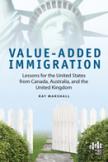Global Movements
Although the moving poem by Emma Lazarus at the foot of the Statue of Liberty envisions “huddled masses yearning to breathe free” at New York harbor, immigration to the United States has historically been more about the push and pull of jobs than about lofty ideals. Indeed, specialists are beginning to tell us that during what some call the Lesser Depression of 2007–9, an actual reduction of immigration, with or without visas, took place, just as happened in the 1930s.
These economic factors have for too long been ignored in U.S. immigration policy, argues Ray Marshall, secretary of labor in the Carter administration, who proposes policies that are “compatible with the value-added principle that foreign workers should complement and not compete with domestic workers.” Where is such a principle applied? Australia, Canada and the United Kingdom.
Marshall, now an economics professor at the University of Texas at Austin, tells the reader that Canada and Australia, with nearly twice the share of foreign-born individuals as the United States and a similar history as nations of immigrants, have a much smaller unauthorized (“illegal”) foreign workforce, as does Britain with about the same share of foreign-born workers.
Granted, Australia and Britain are islands and Canada’s only land border is with an even more prosperous country, so at least some of the credit for these countries’ relatively greater success at controlling the flow of immigrants should go to geography. Still, the three countries’ differing paths focused on “importing more skilled workers relative to less-skilled and family-based immigrants” have yielded intended results.
Australia and Canada began—as did the United States—with large empty spaces that demanded to be filled by immigrants without distinction. Australia and Canada encouraged the addition of people of British stock, while the United States drew from a broader pot of northwestern Europeans.
In 1967 Canada replaced its immigration system based on family ties and national origin with a points-based system that took into account education, language skills, experience in skilled occupations and the applicant’s actual job prospects (including possession of a job offer). Five years later, the Ottawa government ran a very broad legalization program that drew most stealth immigrants out into the open, with documented status. During recessions, Canada continued to accept “high levels of immigration” (250,000 entrants or more a year) based on the idea that the long-term benefits of immigration stability outweigh short-term drawbacks.
Australians had seen themselves as “a European outpost in the Asia-Pacific region whose citizens and leaders were highly motivated to avoid being inundated by migrants from their heavily populated Asian neighbors,” Marshall writes. This is thinking similar to that behind the first U.S. law limiting entry to the United States, which was designed to exclude Chinese immigrants.
Australia replaced “whites-only” policies with a points system designed to attract highly skilled workers, inventors and entrepreneurs from Asia and elsewhere. Policymakers down under also opted for enabling higher wages to draw Australians to worker-hungry occupations and a Working Holiday Maker program that drew young, relatively well-educated foreigners to spend between six months and a year working in Australia.
Until the 1990s, Britain had a “zero net immigration” policy that allowed in just enough people to offset continuing emigration. Economy-based policy had to wait until the Blair government (1997-2007), which expressly borrowed from Australia and Canada by shifting to an employment-based system in a bid to overcome “pressing shortages” in education, welfare and health care occupations and in 2001 to a points system to encourage skills-based immigration in other fields.
That would have been the end of Britain’s story, Marshall writes, except for two unexpected developments. First was the flood of immigration after former Soviet-bloc countries joined the European Union in 2004. (The Polish presence alone, a U.K. sociologist explained to me, has transformed Catholicism into the single largest denomination in Britain for the first time since Henry VIII.) Second were the race riots in Bradby, Burnley and Oldham and the 2005 jihadist attacks on London’s transportation system. In response, Prime Minister David Cameron has attacked British and European multiculturalism as recently as 2011.
The reader will be well rewarded with Marshall’s distillation of “seven lessons” for the United States drawn from this triad of policy twists and turns, mostly because they point to a new consensus that departs from the rhetoric of the past. One of Marshall’s proposals—a nonpartisan appointed commission to adjust policy based on economic data—was earlier floated by the Migration Policy Institute. More novel, Marshall demands that policymakers “refuse to permit the importation of foreign workers to substitute for the education and training of American workers,” almost as if he were challenging U.S. labor protectionism at a union hall.
This article also appeared in print, under the headline “Global Movements,” in the May 14, 2012, issue.








